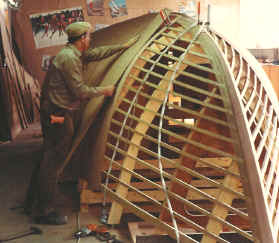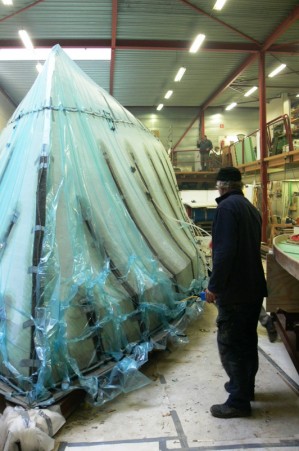Considerations regarding building materials
| steel | aluminium | aluminium/ unpainted |
epoxy composite | polyester | plywood | comments | |
| maintenance |
regular |
regular | little | little | little | regular | |
| impact strength | very strong | very strong | very strong | reasonably strong | strong | moderately strong |
|
| weight |
9 | 7 | 7 | 6 | 7 | 5 |
the higher the number, the |
| cost | 6 | 8 | 6 | 5 | 4 | 4 | the higher the number, the greater the expense. |
| loss of space | 7 | 8 | 8 | 5 | 4 | 4 | the higher the number, the greater the loss of space. |
|
|
Maintenace
Maintenance can be subdivided into two categories: the structural condition of the boat and the cosmetic condition. For example: when the boat is made of steel or plywood, damage to the paint system must be repaired immediatelly. For other materials it is not urgent.
Impact strength
This refers to the strength of the material and the amount of stretch until it breaks. The advantage of metal is, that it has a lot of stretch (up to 20%) which also works as a 'crumple zone'.
Good composites are up to 4 times stronger than standard aluminium, but have less stretch to breaking point (approximately 1.5%). But because of the lighter construction a collision will be less severe.
Lighter ships with small loads are probably strongest in composite; boats with heavy loads will be stronger in metal.
Weight
For a planing hull, additional weight will will give too much resistance. For the long-distance sailor who will take a lot of weight this is an issue of less importance. However, the weight needs to be positioned in the right place, low and in the middle of the ship.
Our centreboarders need a lot of ballast for a safe angle of vanishing stability and would be too heavy and wet (sea spray etc.) if constructed in steel. For these ships aluminium and epoxy composite are more suitable construction materials.
Costs
The costs of the hull and deck are only part of the total costs (see cost indication). For the amateur-builder this can be a decisive factor, as they may not have the expertise to use certain materials. For yachts built at a yard the differences will be small. The advantages of woodcore and plywood are that these materials don't need to be finished at some places on the inside.
Loss of space
Due to some construction techniques using frames and stringers for example, there will be loss of space. With the use of woodcore, polyester and plywood there will be more space on the inside of a ship. This especially applies to ships of a total length up to approx 12 meters.



